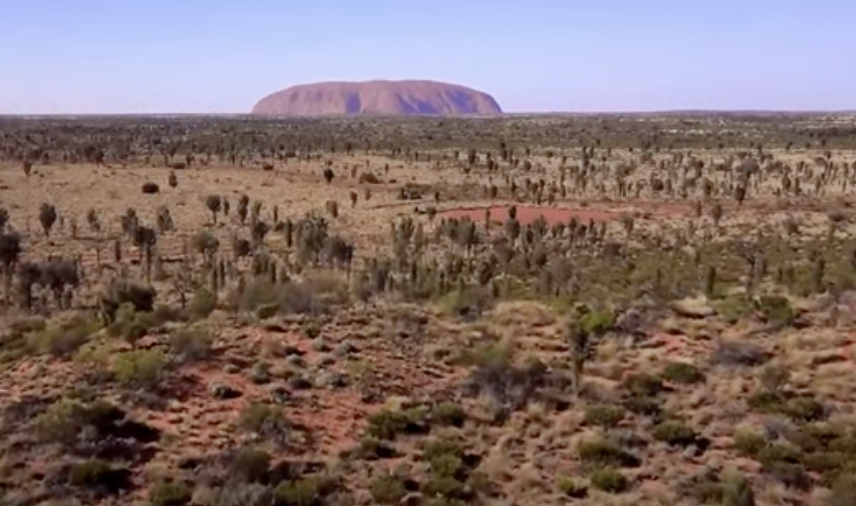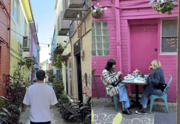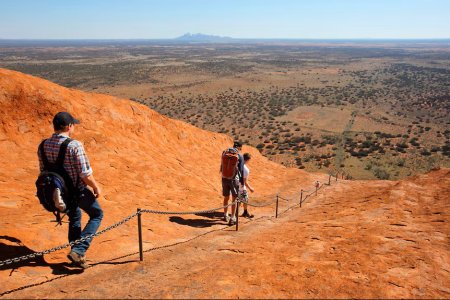
When travel vloggers Britt and Tim Cromie received a lengthy email three months after their Uluru holiday, they thought it was spam. Instead, it was Parks Australia outlining 20 possible offences from their seemingly innocent YouTube video and Instagram posts—and demanding they delete most of their content or face thousands in fines.
Their story has become a wake-up call for Australian travellers, particularly as social media sharing becomes second nature for many seniors documenting family holidays and milestone trips.
In this article
When a holiday snap becomes a legal issue
The couple discovered that anyone wanting to use photos or videos of the park for commercial purposes or public display—including influencers, bloggers, artists and content creators—needs to apply for a media permit. What caught them off guard was how broadly 'commercial' is interpreted.
Current permits cost $250 per day for commercial filming, while photography permits cost $20 per day, on top of the standard $38 park entry fee for a three-day visit.
But the real shock wasn't the costs—it was discovering their innocent actions, like picking up a branch to swat flies, were considered violations worthy of deletion demands.
'You have to apply for a permit, whether you're a content creator, doing brand deals, or just posting personal socials. We weren't aware about that.'
The cultural heart of the restrictions
Uluru and Kata Tjuta have numerous culturally sensitive sites where rock details and features are equivalent to sacred scripture for Anangu people, describing culturally important information that should only be viewed in their original location by specific people, making it inappropriate for images of sensitive sites to be viewed elsewhere.
The Anangu ask that photographs not be taken of certain areas to avoid the chance an Anangu person might accidentally break a taboo by viewing a picture of a ritual site normally forbidden to them, with silhouettes being a striking way to obscure these culturally sensitive areas.
Understanding this cultural context transforms the rules from bureaucratic obstacles into meaningful acts of respect for the world's oldest continuous culture.
What you can and can't photograph
The rules are more nuanced than a simple 'no photos' policy. Throughout sensitive areas, visitors can take images of flora, fauna and people while ensuring they avoid capturing any rock formations, with culturally sensitive sites clearly identified by signs in the park.
The north-east face restrictions
The north-east face, running from Kantju Gorge to Kuniya Piti, is one of the park's most sensitive areas and the side most commonly seen from Ayers Rock Resort, with Anangu asking that photographers only take wide shots from a distance and avoid showing details on the top-left side of the rock, with the best time being 1-2 hours before sunset when naturally occurring shadows obscure the sacred sites.
Complete no-photo zones
The couple discovered that Kata Tjuta's Valley of the Winds walk requires shooting the entire set of domes in a frame to satisfy the wishes of the Anangu people, which rules out some landscape scenes from the viewing platform.
Essential photography guidelines
- Wide shots from a distance are generally acceptable
- No close-up details of rock formations in sensitive areas
- Flora and fauna photography is permitted throughout
- Signage clearly marks restricted areas
- Night photography must be taken from outside the park
When personal becomes commercial
Many visitors don't realise that activities requiring permits include filming, taking photos, journalism, recording audio or artworks depicting Uluru or Kata Tjuta for commercial and public purposes, which includes social media influencers, content creators and bloggers.
The line between personal and commercial use has blurred in the social media age. While sharing a family photo on Facebook typically wouldn't trigger permit requirements, regular posting, having followers, or any monetisation can shift you into commercial territory.
Practical guidance for senior travellers
Before you go
To check if you need a permit or to apply for one, visit the Department of Climate Change, Energy, the Environment and Water website or email [email protected].
All permit holders must undertake the park's media briefing prior to commencing photography activities.
What's genuinely allowed for tourists
Regular tourists taking personal photos and videos for family sharing don't need permits, provided the content isn't used commercially or shared publicly in ways that could be considered promotional.
Shooting Uluru from a distance is fine, just find a safe, legal place to pull over, but be aware that as you walk around the base of the rock, there are marked culturally important areas where photography is prohibited.
Photography equipment tips for Uluru
Bring your best quality lenses and a sturdy tripod, pack cleaning cloths and blowers to keep sand off equipment, stay on marked walking tracks and within authorised areas at all times, and when photographing from roadside, ensure you park where there are white lines.
Night photography alternatives
While Central Australia offers superb night sky photography opportunities and Uluru silhouetted against the Milky Way has become iconic, all visitors must exit the park by closing time, meaning night-sky shots must be taken from outside the park, with a great spot being an elevated lookout on a sand dune beside the Lasseter Highway, about halfway between the park entry station and Ayers Rock Resort.
The enforcement reality
Drones and other remote controlled devices are prohibited in Uluru-Kata Tjuta National Park under the Environment Protection and Biodiversity Conservation Act, with penalties applying for unauthorised use.
Since 2019, when climbing was banned, enforcement has intensified. The first prosecution came in 2022 when a 44-year-old Victorian was fined $2,500 for illegally scaling the sacred site, with potential penalties now exceeding $10,000.
Large sections of the rock have since been placed off-limits to photography, while other parts can only be captured with a permit. Offenders risk fines exceeding $5,000.
The Cromies' case shows that authorities monitor online content and can pursue violations months after they occur. However, they also demonstrated understanding when the couple showed respect and willingness to comply.
A learning opportunity, not a deterrent
The couple's experience, while confronting, ultimately strengthened their respect for Anangu culture. They emphasised they weren't criticising the rules but sharing their experience to help other travellers avoid similar mistakes.
Their video sparked mixed reactions online, from praise for their transparency to frustration about the complexity of the rules. However, most commenters supported protecting sacred sites and respecting Traditional Owners' wishes.
Did you know?
Did you know?
Uluru-Kata Tjuta National Park is dual-listed on the UNESCO World Heritage List for both its outstanding natural and cultural values—recognition of both its geological significance and its importance to Aboriginal culture spanning tens of thousands of years.
Essential steps for photographers
- Research first: Visit the official Parks Australia website and familiarise yourself with current guidelines
- Consider a permit: If you're documenting the trip for any public sharing or have a significant social media presence, apply early
- Respect signage: Culturally sensitive sites are clearly identified by signs in the park
- When in doubt, don't: As Britt Cromie advised, 'if in doubt, put the camera away'
Understanding the bigger picture
This isn't about making tourism difficult—it's about preserving culture. Uluru holds significant cultural value that makes photographs more meaningful, as it's not simply a landscape but a living landscape where Aboriginal communities observe traditions and spiritual practices, with photographers able to tell stories about how these sites form integral parts of Anangu lifestyles.
The restrictions ensure that one of Australia's most sacred sites remains protected for future generations while still allowing respectful appreciation and documentation.
What This Means For You
The Cromies' experience serves as a valuable reminder that respectful travel requires more than good intentions—it demands understanding and preparation. Their willingness to share their mistakes openly has created an important learning opportunity for all Australian travellers.
For seniors planning that bucket-list trip to Uluru, the message is clear: a little research beforehand ensures your memories remain just that—cherished personal moments rather than unwanted legal complications.
Original Article
https://www.dailymail.co.uk/news/ar...tml?ns_mchannel=rss&ns_campaign=1490&ito=1490
Photography | Uluṟu-Kata Tjuṯa National Park | Parks Australia
Cited text: If you want to use photos or videos of the park for commercial purposes or public display (including influencers, bloggers, artists and content creato...
Excerpt: The couple discovered that anyone wanting to use photos or videos of the park for commercial purposes or public display—including influencers, bloggers, artists and content creators—needs to apply for a media permit
https://uluru.gov.au/things-do/activities/photography/
Photography | Uluṟu-Kata Tjuṯa National Park | Parks Australia
Cited text: Uluṟu and Kata Tjuṯa have a number of culturally sensitive sites. The rock details and features at these sites are equivalent to sacred scripture for ...
Excerpt: Uluru and Kata Tjuta have numerous culturally sensitive sites where rock details and features are equivalent to sacred scripture for Anangu people, describing culturally important information that should only be viewed in their original…
https://uluru.gov.au/things-do/activities/photography/
How to photograph Uluru, Australia’s iconic monolith | National Geographic
Cited text: The Anangu ask photographs not be taken of certain areas on Uluru, in order to avoid the chance an Anangu person might accidentally break a taboo by v...
Excerpt: The Anangu ask that photographs not be taken of certain areas to avoid the chance an Anangu person might accidentally break a taboo by viewing a picture of a ritual site normally forbidden to them, with silhouettes being a striking way to…
https://www.nationalgeographic.com/travel/article/how-to-photograph-uluru
Photography | Uluṟu-Kata Tjuṯa National Park | Parks Australia
Cited text: Throughout sensitive areas, you are welcome to take images of flora, fauna and people while ensuring that you avoid capturing any rock formations. Cul...
Excerpt: Throughout sensitive areas, visitors can take images of flora, fauna and people while ensuring they avoid capturing any rock formations, with culturally sensitive sites clearly identified by signs in the park
https://uluru.gov.au/things-do/activities/photography/
Photography | Uluṟu-Kata Tjuṯa National Park | Parks Australia
Cited text: Running from Kaṉtju Gorge to Kuniya Piti, the north-east face of Uluṟu is one of the park’s most sensitive areas.
Excerpt: The north-east face, running from Kantju Gorge to Kuniya Piti, is one of the park's most sensitive areas and the side most commonly seen from Ayers Rock Resort, with Anangu asking that photographers only take wide shots from a distance and…
https://uluru.gov.au/things-do/activities/photography/
Photography | Uluṟu-Kata Tjuṯa National Park | Parks Australia
Cited text: Given the north-east face’s great cultural significance, Aṉangu ask that photographers only take wide shots from a distance and avoid showing any of t...
Excerpt: The north-east face, running from Kantju Gorge to Kuniya Piti, is one of the park's most sensitive areas and the side most commonly seen from Ayers Rock Resort, with Anangu asking that photographers only take wide shots from a distance and…
https://uluru.gov.au/things-do/activities/photography/
Uluru for Photographers—Photography by Ewen Bell
Cited text: You have to shoot the entire set of domes in a frame to satisfy the wishes of the Anangu people, which rules out some very nice landscapoe scenes from...
Excerpt: Kata Tjuta's Valley of the Winds walk requires shooting the entire set of domes in a frame to satisfy the wishes of the Anangu people, which rules out some landscape scenes from the viewing platform
https://ewenbell.com/blog/Uluru_for_Photographers
Media centre | Uluṟu-Kata Tjuṯa National Park | Parks Australia
Cited text: If our park manager considers a story to be ‘news of the day’, then the requirement for news media to have a permit may be waived.
Excerpt: activities requiring permits include filming, taking photos, journalism, recording audio or artworks depicting Uluru or Kata Tjuta for commercial and public purposes, which includes social media influencers, content creators and bloggers
https://uluru.gov.au/news/media-centre/
Uluṟu-Kata Tjuṯa National Park | Online Services—Department of Climate Change, Energy, the Environment and Water
Cited text: Uluru-Kata Tjuta National Park is Aboriginal land, jointly managed by its traditional owners Anangu and the Director of National Parks in accordance w...
Excerpt: activities requiring permits include filming, taking photos, journalism, recording audio or artworks depicting Uluru or Kata Tjuta for commercial and public purposes, which includes social media influencers, content creators and bloggers
https://onlineservices.environment.gov.au/parks/uluru-kata-tjuta-national-park
Media centre | Uluṟu-Kata Tjuṯa National Park | Parks Australia
Cited text: ...
Excerpt: To check if you need a permit or to apply for one, visit the Department of Climate Change, Energy, the Environment and Water website or email [email protected]
https://uluru.gov.au/news/media-centre/
Uluṟu-Kata Tjuṯa National Park | Online Services—Department of Climate Change, Energy, the Environment and Water
Cited text: You will need to apply for a permit if you wish to conduct filming, audio capture, photography or artwork in Uluṟu-Kata Tjuṯa National Park for commer...
Excerpt: To check if you need a permit or to apply for one, visit the Department of Climate Change, Energy, the Environment and Water website or email [email protected]
https://onlineservices.environment.gov.au/parks/uluru-kata-tjuta-national-park
Additional permits | Uluru-Kata Tjuta National Park
Cited text:
Excerpt: All permit holders must undertake the park's media briefing prior to commencing photography activities
https://parksaustralia.gov.au/uluru/plan/permits/
The Guide To Photographing Uluru — Australian Nature & Landscape Photography
Cited text: Shooting Uluru from a distance is fine (just find a safe, legal place to pull over), however also be aware that as you walk around the base of the roc...
Excerpt: Shooting Uluru from a distance is fine, just find a safe, legal place to pull over, but be aware that as you walk around the base of the rock, there are marked culturally important areas where photography is prohibited
https://mitchgreenphotos.com/articles/the-guide-to-photographing-uluru
Photography | Uluṟu-Kata Tjuṯa National Park | Parks Australia
Cited text: If you’re an enthusiastic photographer or videographer, you’ll want to bring your best quality lenses and a sturdy tripod. Make sure you pack some cle...
Excerpt: Bring your best quality lenses and a sturdy tripod, pack cleaning cloths and blowers to keep sand off equipment, stay on marked walking tracks and within authorised areas at all times, and when photographing from roadside, ensure you park…
https://uluru.gov.au/things-do/activities/photography/
Photography | Uluṟu-Kata Tjuṯa National Park | Parks Australia
Cited text: If you want to photograph from the side of the road, make sure you park where there are white lines.
Excerpt: Bring your best quality lenses and a sturdy tripod, pack cleaning cloths and blowers to keep sand off equipment, stay on marked walking tracks and within authorised areas at all times, and when photographing from roadside, ensure you park…
https://uluru.gov.au/things-do/activities/photography/
Photography | Uluṟu-Kata Tjuṯa National Park | Parks Australia
Cited text: Central Australia is a superb place to photograph the night sky, and the silhouette of Uluṟu against the Milky Way has become an iconic Australian sho...
Excerpt: While Central Australia offers superb night sky photography opportunities and Uluru silhouetted against the Milky Way has become iconic, all visitors must exit the park by closing time, meaning night-sky shots must be taken from outside…
https://uluru.gov.au/things-do/activities/photography/
Photography | Uluṟu-Kata Tjuṯa National Park | Parks Australia
Cited text: Drones and other remote controlled devices are prohibited in Uluṟu-Kata Tjuṯa National Park under the Environment Protection and Biodiversity Conserva...
Excerpt: Drones and other remote controlled devices are prohibited in Uluru-Kata Tjuta National Park under the Environment Protection and Biodiversity Conservation Act, with penalties applying for unauthorised use
https://uluru.gov.au/things-do/activities/photography/
Photography | Uluṟu-Kata Tjuṯa National Park | Parks Australia
Cited text: ... Uluru-Kata Tjuta National Park is dual-listed on the UNESCO World Heritage List for its outstanding natural and cultural values · Accessibility Gu...
Excerpt: Uluru-Kata Tjuta National Park is dual-listed on the UNESCO World Heritage List for both its outstanding natural and cultural values
https://uluru.gov.au/things-do/activities/photography/
Photography | Uluru-Kata Tjuta National Park
Cited text: ... Uluru-Kata Tjuta National Park is dual-listed on the UNESCO World Heritage List for its outstanding natural and cultural values · Accessibility Gu...
Excerpt: Uluru-Kata Tjuta National Park is dual-listed on the UNESCO World Heritage List for both its outstanding natural and cultural values
https://parksaustralia.gov.au/uluru/do/photography/
Photography | Uluṟu-Kata Tjuṯa National Park | Parks Australia
Cited text: Culturally sensitive sites are also clearly identified by signs in the park.
Excerpt: Culturally sensitive sites are clearly identified by signs in the park
https://uluru.gov.au/things-do/activities/photography/
Photography | Uluru-Kata Tjuta National Park
Cited text: Culturally sensitive sites are also clearly identified by signs in the park.
Excerpt: Culturally sensitive sites are clearly identified by signs in the park
https://parksaustralia.gov.au/uluru/do/photography/
A Photographer's Guide to Capturing Uluru
Cited text: Besides its aesthetic appeal, Uluru holds significant cultural value, making photos taken here more enjoyable. It is not simply a landscape, but inste...
Excerpt: Uluru holds significant cultural value that makes photographs more meaningful, as it's not simply a landscape but a living landscape where Aboriginal communities observe traditions and spiritual practices, with photographers able to tell…
https://wildlifetours.com.au/blog/ayers-rock-uluru/a-photographers-guide-to-capturing/
Have you had any surprising encounters with photography rules during your travels? What questions do you have about visiting sacred or culturally significant sites respectfully? Share your experiences and thoughts in the comments below.








